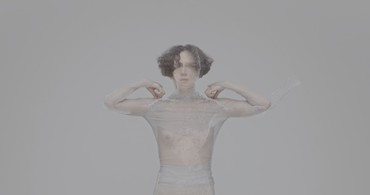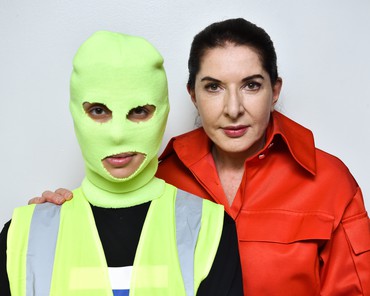
Ashley Overbeek is the director of strategic initiatives at Gagosian, where she has the pleasure of working with artists on Web3 and digital projects. Overbeek is also an advisory-board member of the Art and Antiquities Blockchain Consortium, a 501c3 nonprofit, and a guest speaker on the subject of art and blockchain technology at Stanford and Columbia University.
In April 2022, Salem Ilese released a song on TikTok. It went something like this:
Mention NFTs one more time
And it’s guaranteed we’re not fucking tonightI don’t care about your crypto, boy
Not at all, not even one BitcoinI tried to care about you but there’s no point
You’re too in love with all your crypto, boy
Needless to say, the song went viral.
Ilese, looking to find a way to use her platform to shift attention to urgent social issues, reached out to Pussy Riot cofounder Nadya Tolokonnikova to partner on a charitable NFT project aptly titled “Crypto Boy.” The project, which combined Ilese’s eponymous song and visual art by Tolokonnikova, would go on to raise over 80 ETH (the cryptocurrency ether; worth $250,000 at the time) for New York’s Center for Reproductive Rights.
Art for impact is nothing new to Tolokonnikova, who in 2012 was sentenced to two years in a Russian prison after a performance protesting the regime of Vladimir Putin and its relationship with the Orthodox Church. Since her release, Tolokonnikova has continued to push for world change and for women’s and LGBTQ+ rights, in part through her art and musical performances. More recently, she’s found an unexpected tool for activism: blockchain technology.
Tolokonnikova first got involved in the Web3 space at the beginning of 2021. She is known for her live performances, and the guardrails that the pandemic imposed on in-person activity were frustrating for her at times: “In my soul I felt like I wasn’t doing enough,” she told me over a Zoom call, “that I’m not able to use those tools that I used to have before because I just can’t talk and can’t perform.” So she began exploring ways to translate her art and activism digitally:
Myself and a lot of other artists started to get interested in this new technology, NFTs. I believe that [the crypto art movement] will be recognized later as an art movement in the same fashion as the Russian avant-garde movement or the Futurists. It is revolutionary to me in the way it states that digital art is art. The traditional museum/gallery system is still structured so much around physical objects. So the possibility of creating art online, in the metaverse, was groundbreaking for me because it didn’t matter to me if I wasn’t able to travel, I was still able to do my activism and show people my art and, more than that, sell my art digitally.
Pussy Riot and Tolokonnikova sold their first NFT series in early 2021: “And I started from selling one of my visual pieces,” she remembers, “called Panic Attack, for around $400,000, which was an insane sum for me, especially in the middle of the pandemic when I got money for hardly anything, just surviving on Patreon and selling merch. That sale enabled me to fund a shelter for the victims of domestic violence in Russia in one of the harshest regions for women to survive. It’s close to Chechnya, where women still are considered property.”
Pussy Riot, Panic Attack 1. Terrestrial Paradise, 2021, video, color, sound, 38 sec., directed by Asad J. Malik
Panic Attack is an example of what Tolokonnikova calls “warm crypto.” Not to be confused with the technical terms related to types of cryptocurrency storage, warm crypto is a humanizing approach to blockchain technologies. Instead of exploiting crypto as a device to generate as much money as quickly as possible, the warm-crypto community seeks to leverage blockchain technology as a tool for positive impact. “Crypto is not just for selling NFTs to make more money,” says Tolokonnikova. “I never was able to be that person. And it’s not wrong to be that type of person, but I’m just an activist. I’m a community builder. So I would always find a way [to use blockchain technology] to raise money for political prisoners, for independent media outlets in Russia that told the true story about Putin’s regime, for Ukraine, and for reproductive rights.”
Tolokonnikova has found that “crypto works for activists.” Digital initiatives reap tangible benefits in the physical world. In March 2022, UkraineDAO, an organization founded by Tolokonnikova, raised over $7 million to donate to Ukrainian civilian organizations who help those suffering from the war initiated by Putin. And at around the same time, Tolokonnikova founded UnicornDAO, its mission being to build infrastructure for a feminist and queer revolution on the blockchain, largely through collecting and showcasing art by women, nonbinary, and LGBTQ+ creators. UnicornDAO has raised more than $5 million for a variety of female and LGBTQ+ empowerment initiatives, including LegalAbortion.eth, which secured half a million dollars for nonprofits championing reproductive rights in the aftermath of the reversal of Roe v. Wade.
Fundraising in the crypto space often involves DAOs—decentralized autonomous organizations. A DAO is a governance structure that has no centralized authority; rather, decision-making power is distributed across its members, all of whom hold governance tokens. DAO members use these tokens to vote on the organization’s decisions, such as how funds are spent or how many members to include. DAOs raise funds in a variety of ways, but commonly require members to exchange their own fiat currency for a proportional share of governance tokens.
The DAO is a working model for different systems of governance, and it was appealing to me because of my interests in political theory; I’m an activist forever.
Nadya Tolokonnikova
For Tolokonnikova, a “DAO can be pretty much everything you want it to be. It’s a group of people who decide how you’re going to govern this entity that they form. And you write your own constitution. The DAO is a working model for different systems of governance, and it was appealing to me because of my interests in political theory; I’m an activist forever. And it’s always interesting to me how alternative models of governance can work. Oftentimes DAOs can have more elements of direct democracy than systems that we’re usually using.”
For UnicornDAO, the goal was to make a clear, straightforward structure: “We decided to make [the governance structure] simple. It’s pretty flat; everyone has a similar amount of [governance] tokens. Everyone who joined the DAO either invested a lot of their own time and resources and their network, like me and my cofounder John Caldwell, or invested 50 ETH for their seat. And every week we come together on a community call and we decide how we’re going to invest this ETH that we have in our treasury.”
For artworks priced lower than 5 ETH, the DAO uses a system it calls “emoji consensus.” Using a private server on the social media platform Discord, UnicornDAO members propose potential acquisitions by posting images alongside their argument for why these works would make good additions to the group’s collection. Other members “react” to the online proposal using emojis. Once the post attains a threshold number of emoji reactions, the member is able to purchase the work on behalf of the DAO. For pricier works, the DAO uses a more formalized ballot and voting system. So far, UnicornDAO has purchased works from a diverse group of female, nonbinary, and LGBTQ+ artists, including Claire Silver, Sputniko! (aka Hiro Ozaki), Ania Catherine and Dejha Ti, Sasha Katz, Olive Allen, Sarah Meyohas, Laurie Simmons, Marina Abramović, and Yulia Shur.
The collecting philosophy of UnicornDAO is aimed at the ongoing issue of representation in the art world. The organization cites a finding by the art-market research firm ArtTactic, which reported in late 2021 that only 5 percent of NFT sales were by female-identifying artists. Tolokonnikova argues,
By creating more diversity, you attract more people. . . . I feel like we just need to break through this cage. Right now I talk with a lot of artists who do not want to join the crypto party because they expect it to be overfilled with dorky guys who don’t know how to talk to a nonbinary person. And so people are just like, No, they aren’t going to come. But I feel that just through people who are doing things for the right reasons in this space, like other members of UnicornDAO, me and my friends—we’ll just attract the right crowd and it’s just a matter of time.
We are trying to change [the crypto space] through bringing more culture and just high-quality art. So we’re trying to push for this warm crypto and it’s obviously not just us. The work that you’ve done with Takashi [Murakami] definitely falls under this idea because it brings actual value to the crypto world that can be understood by people outside of the crypto bro den.
For Tolokonnikova, the problematic crypto bro identity is rooted not in gender but in mindset. “I feel like weirdly enough a girl can be a crypto boy as well if she lacks self-awareness. I think the first characteristic of a crypto boy is a lack of self-awareness. So they can just talk at you for hours without even noticing that you’ve fallen asleep. So a crypto bro to me does not care about feminism, doesn’t care about rights of nonbinary people, trans people. He doesn’t care about the war in Ukraine. He just lives for, I don’t know . . . I don’t know what he lives for but he’s lame,” Tolokonnikova laughs.
A shift away from the crypto bro mindset creates the potential for reform. Tolokonnikova points to the engagement she saw from some former crypto bros through UnicornDAO’s LegalAbortion.eth initiative, a cryptocurrency wallet that functions as an online donation center to collect ETH for reproductive-rights organizations such as Planned Parenthood: “When we kicked things off with Salem, we raised $250,000 for . . . the Center for Reproductive Rights. I feel like everyone who contributed to that, they changed. Maybe they were not all crypto bros to start with, but I feel like [the initiative] actually enabled a bunch of crypto bros to change their identity.”
Tolokonnikova and UnicornDAO continue to work on projects to warm the crypto space. In December 2022, she plans to represent Pussy Riot in a collaboration with the artist Judy Chicago based on Chicago’s series What if Women Ruled the World? (2020). The project is to begin with a live conversation between Chicago and Tolokonnikova at the ICA Miami during Art Basel Miami Beach. “To me, it’s insanely cool because she seems like she’s just been making revolutionary art and statements and practices since forever,” Tolokonnikova smiles, “and to be able to work with her on this, it’s a big honor. Judy has a set of questions and I’m going to be responding with questions or with statements and it’s going to launch a community-driven project where people can come up with their own answers or questions to answer Judy’s original questions.”
Both personally and through UnicornDAO, Tolokonnikova is working on crypto art initiatives with other established women artists besides Chicago, including Abramović and Jenny Holzer. “I want to help present a broader culture in this scene,” she says, “because I want it to be more than just people trading cartoons to get rich.”
DMINTI Presents: Judy Chicago in conversation with Nadya Tolokonnikova, ICA Miami, December 1, 2022















